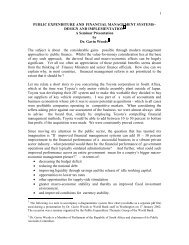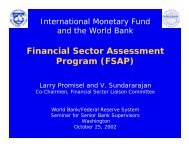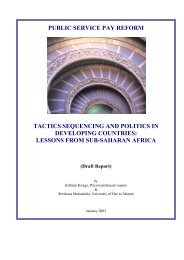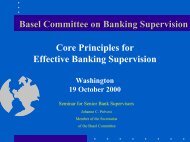Using the Property Tax for Value Capture: A Case ... - World Bank
Using the Property Tax for Value Capture: A Case ... - World Bank
Using the Property Tax for Value Capture: A Case ... - World Bank
You also want an ePaper? Increase the reach of your titles
YUMPU automatically turns print PDFs into web optimized ePapers that Google loves.
that <strong>the</strong> moment was ideal <strong>for</strong> recovering <strong>the</strong> investment and productive activities that hadbeen paralyzed during <strong>the</strong> previous high-inflation period.In summary, <strong>the</strong> following factors encouraged Porto Alegre's initiative to use <strong>the</strong> property taxas an instrument <strong>for</strong> simultaneously capturing increased land value, deterring landspeculation, and promoting social fairness and economic growth:· Stimulation of urban land occupation and development, since <strong>the</strong> private market was notresponding positively to <strong>the</strong> demand from low- and middle-income residents.· Reduction of <strong>the</strong> housing shortfall.Provision of assistance to low-income families, guaranteeing better living and workingopportunities.· Recovery of land value generated by public investment, by encouraging individuals whohad been favored by public investment to return those benefits to <strong>the</strong> community.· Avoidance of large additional investments in public infrastructure and services by applyingfinancial resources rationally.Government ActionsThe Brazilian Constitution (1988) defines <strong>the</strong> property tax as a tax on urban land andbuildings and specifies that it can be used as an instrument of urban policy to promote <strong>the</strong>rational use of land to generate social benefits to <strong>the</strong> community at large. This provisionallowed Porto Alegre to undertake <strong>the</strong> following actions:· Define priority urban zones <strong>for</strong> development and occupation. The process involved <strong>the</strong>selection of five distinct areas characterized by high-quality urban infrastructure, equipmentand services. These areas would support a larger population density without any additionalpublicinvestment.· Identify 120 vacant sites ranging from 3,000 to 360,000 square metres (m 2 ) in <strong>the</strong> priorityzones.· Introduce local legislation requiring <strong>the</strong> development of <strong>the</strong> selected properties within giventime periods. The law established that if <strong>the</strong> periods specified <strong>for</strong> developing <strong>the</strong> sites werenot met <strong>the</strong> property tax on those sites would be made progressive. The tax rate would beraised by 20 percent increments on an annual basis up to a maximum rate of 30 percent. Thebasic rates <strong>for</strong> vacant land vary from 5 to 6 percent of <strong>the</strong> property market value.· Grant priority to construction projects on <strong>the</strong> designated sites. The City Council institutionsresponsible <strong>for</strong> planning permits would facilitate construction and occupation.Effectiveness of <strong>the</strong> InitiativeThe legislation was promulgated at <strong>the</strong> end of 1993 and <strong>the</strong> government started to implementit in 1994. The proposal was supported by both ruling and opposition party members of <strong>the</strong>City Council, which is responsible <strong>for</strong> approving decisions on matters of municipallegislation.As of October 1997, <strong>the</strong> initiative has not yet achieved its desired results. Only five of <strong>the</strong>120 vacant sites are being developed. The landowners of 50 properties are paying <strong>the</strong>property tax at <strong>the</strong> progressive rate. Three of <strong>the</strong> properties were removed from <strong>the</strong> listbecause <strong>the</strong>y had been incorrectly included in <strong>the</strong> first place due to inaccurate records about<strong>the</strong>ir physical characteristics.The development status of <strong>the</strong> remaining 62 properties has not been defined. Some are owned


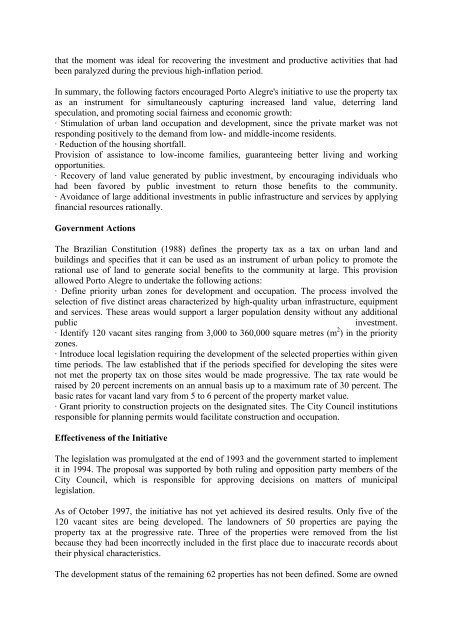
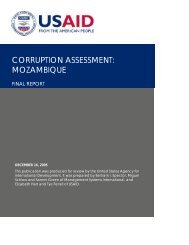

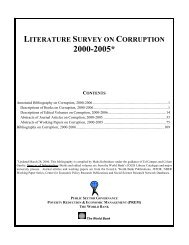
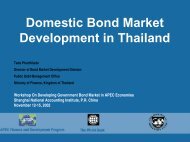
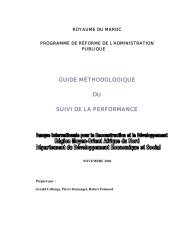
![Budget Execution: Overview [PDF 453K]; Bill Dorotinsky - World Bank](https://img.yumpu.com/47844909/1/190x143/budget-execution-overview-pdf-453k-bill-dorotinsky-world-bank.jpg?quality=85)
